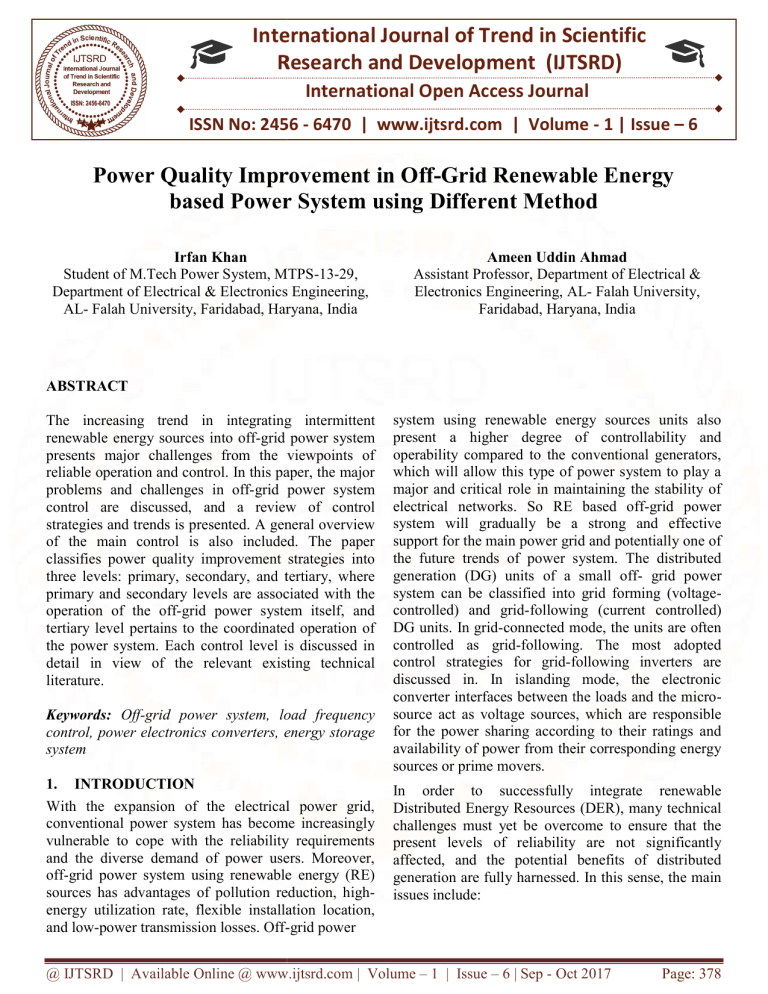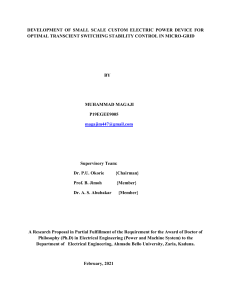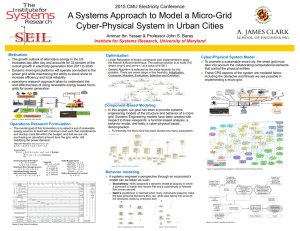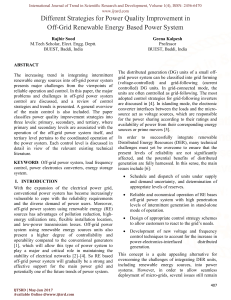
International Journal of Trend in Scientific
Research and Development (IJTSRD)
International Open Access Journal
ISSN No: 2456 - 6470 | www.ijtsrd.com | Volume - 1 | Issue – 6
Power Quality Improvement in Off-Grid
Grid Renewable Energy
based
ased Power System using
sing Different Method
Irfan Khan
Student of M.Tech Power System, MTPS
MTPS-13-29,
Department of Electrical & Electronics Engineering,
AL- Falah University,
sity, Faridabad, Haryana, India
Ameen Uddin Ahmad
Assistant Professor, Department of Electrical &
Electronics Engineering, ALAL Falah University,
Faridabad, Haryana, India
ABSTRACT
The increasing trend in integrating intermittent
renewable energy sources into off-grid
grid power system
presents major challenges from the viewpoints of
reliable operation and control. In this paper, the major
problems and challenges in off-grid
grid power system
control are discussed, and a review of control
strategies and trends is presented. A general overview
of the main control is also included. The paper
classifies power quality improvement strategies into
three levels: primary, secondary, and tertiary, where
primary and secondary levels are associated with the
operation of the off-grid
grid power system itself, and
tertiary
iary level pertains to the coordinated operation of
the power system. Each control level is discussed in
detail in view of the relevant existing technical
literature.
Keywords: Off-grid
grid power system, load frequency
control, power electronics converters,
nverters, eenergy storage
system
1. INTRODUCTION
With the expansion of the electrical power grid,
conventional power system has become increasingly
vulnerable to cope with the reliability requirements
and the diverse demand of power users. Moreover,
off-grid
grid power system using renewable energy (RE)
sources
es has advantages of pollution reduction, high
highenergy utilization rate, flexible installation location,
and low-power transmission losses. Off--grid power
system using renewable energy sources units also
present a higher degree of controllability and
operability
erability compared to the conventional generators,
which will allow this type of power system to play a
major and critical role in maintaining the stability of
electrical networks. So RE based off-grid
off
power
system will gradually be a strong and effective
support for the main power grid and potentially one of
the future trends of power system. The distributed
generation (DG) units of a small offoff grid power
system can be classified into grid forming (voltage(voltage
controlled) and grid-following
following (current controlled)
controlle
DG units. In grid-connected
connected mode, the units are often
controlled as grid-following.
following. The most adopted
control strategies for grid-following
following inverters are
discussed in. In islanding mode, the electronic
converter interfaces between the loads and the micromicro
source act as voltage sources, which are responsible
for the power sharing according to their ratings and
availability of power from their corresponding energy
sources or prime movers.
In order to successfully integrate renewable
Distributed Energy Resources
rces (DER), many technical
challenges must yet be overcome to ensure that the
present levels of reliability are not significantly
affected, and the potential benefits of distributed
generation are fully harnessed. In this sense, the main
issues include:
@ IJTSRD | Available Online @ www.ijtsrd.com | Volume – 1 | Issue – 6 | Sep - Oct 2017
Page: 378
International Journal of Trend in Scientific Research and Development (IJTSRD) ISSN: 2456-6470
Schedule and dispatch of units under supply and
demand uncertainty, and determination of
appropriate levels of reserves.
Reliable and economical operation of RE bases
off-grid power system with high penetration levels
of intermittent generation in stand-alone mode of
operation.
Design of appropriate control strategy schemes to
allow customers to react to the grid’s needs.
Development of new voltage and frequency
control techniques to account for the increase in
power-electronics-interfaced
distributed
generation
This concept is a quite appealing alternative for
overcoming the challenges of integrating DER units,
including renewable energy sources, into power
systems. However, in order to allow seamless
deployment of micro-grids, several issues still remain
unsolved. Currently, effort is being put into the design
of special protection schemes and control systems that
ensure reliable, secure and economical operation of
micro-grids in either grid-connected or stand-alone
mode. This paper presents a general overview of the
existing technologies and remaining challenges in
micro-grid control.
2. Off-Grid Power System using RE Sources
The concept of small off-grid power system using RE
sources was first introduced in the technical literature
in as a solution for the reliable integration of DERs,
including Energy Storage Systems (ESSs) and
controllable loads. Such micro-grid would be
perceived by the main grid as a single element
responding to appropriate control signals. Although a
detailed definition of micro-grids is still under
discussion in technical forums, a micro-grid can be
described as a cluster of loads, Distributed Generation
(DG) units and ESSs operated in coordination to
reliably supply electricity, connected to the host
power system at the distribution level at a single point
of connection, the Point of Common Coupling (PCC).
The adoption of micro-grids as the paradigm for the
massive integration of distributed generation will
allow technical problems to be solved in a
decentralized fashion, reducing the need for an
extremely ramified and complex central coordination
and facilitating the realization of the Smart Grid.
Fig 1: Schematic diagram of a generic multipleDER micro-grid
In general, a micro-grid can have any arbitrary
configuration, as illustrated in Fig. 1; however, some
entities, such as the Consortium for Electric
Reliability Technology Solutions (CERTS), promote a
configuration in which loads are connected to the
feeders with existing generation [8]. In some cases,
where a strong coupling between the operation of
different energy carrier systems (heating, hot water,
etc.) exists, micro-grids can integrate and operate all
these energy carriers in coordination.
3. Requirements for Control and Protection
Micro-grids and integration of DER units in general,
introduce a number of operational challenges that
need to be addressed in the design of control and
protection systems in order to ensure that the present
levels of reliability are not significantly affected and
the potential benefits of DG are fully harnessed. Some
of these challenges arise from invalid assumptions
typically applied to conventional distribution systems,
while others are the result of stability issues formerly
observed only at a transmission system level.
The most relevant challenges in micro-grid protection
and control include:
Bidirectional power flows: While distribution
feeders were initially designed for unidirectional
power flow, integration of DG units at low
voltage levels can cause reverse power flows and
lead to complications in protection coordination,
undesirable power flow patterns, fault current
distribution, and voltage control.
Stability issues: Local oscillations may emerge
from the interaction of the control systems of DG
units, requiring a thorough small-disturbance
stability analysis. Moreover, transient stability
@ IJTSRD | Available Online @ www.ijtsrd.com | Volume – 1 | Issue – 6 | Sep - Oct 2017
Page: 379
International Journal of Trend in Scientific Research and Development (IJTSRD) ISSN: 2456-6470
analyses are required to ensure seamless transition
between the grid-connected and stand-alone
modes of operation in a micro-grid.
Modeling: Prevalence of three-phase balanced
conditions, primarily inductive transmission lines,
and constant-power loads are typically valid
assumptions when modeling conventional systems
at a transmission level; however, these do not
necessarily hold valid for micro-grids, and
consequently models need to be revised.
Low inertia: Unlike bulk power systems where
high number of synchronous generators ensures a
relatively large inertia, micro-grids might show a
low-inertia characteristic, especially if there is a
significant share of power electronic-interfaced
DG units. Although such an interface can enhance
the system dynamic performance, the low inertia
in
the
system
can
lead
to
severe
f r e q u e n c y deviations in stand-alone operation
if a proper control mechanism is not implemented.
Uncertainty: The economical and reliable
operation of micro-grids requires a certain
level
of coordination
among
different
DERs. This coordination becomes more
challenging in isolated micro-grids, where the
critical demand- supply balance and typically
higher component failure rates require solving a
strongly coupled problem over an extended
horizon, taking into account the uncertainty of
parameters such as load profile and weather
forecast. This uncertainty is higher than those in
bulk power systems, due to the reduced number of
loads and highly correlated variations of available
energy resources (limited averaging effect).
The control system must be able to ensure the reliable
and economical operation of the micro-grid, while
overcoming the aforementioned challenges. In
particular, desirable features of the control system
include:
Output control: Output voltages and currents of the
various (DER) units must track their reference
values and ensure oscillations are properly damped.
Power balance: DER units in the micro-grid must
be able to accommodate sudden active power
imbalances, either excess or shortage, keeping
frequency and voltage deviations within acceptable
ranges.
DSM: Where applicable, proper DSM mechanisms
must be designed in order to incorporate the ability
to control a portion of the load. Additionally, for
the electrification of remote communities with
abundant local renewable resources, the active
participation of the local community may be
beneficial in order to design cost-effective DSM
strategies that enhance load-frequency control [8].
Economic dispatch: An appropriate dispatch of
DER units participating in the operation of a
micro-grid can significantly reduce the operating
costs, or increase the profit. Reliability
considerations must also be taken into account in
the dispatch of units, especially in stand-alone
operation.
Transition between modes of operation: A desirable
feature of micro-grids is the ability to work in both
grid-connected and stand-alone modes of operation,
including a smooth transition between them. Different
control strategies might be defined for each mode of
operation and,
therefore, a high-speed islanding
detection algorithm is very important in order to
adjust the control strategy accordingly.
In the micro-grid environment, characterized by
having frequent and multiple changes in topology,
robustness of controllers is desired traits. Availability
of measurements, communication, and high-speed
computational facilities are additional challenges for
all the above requirements; for this reason, an attempt
should be made in order to reduce the need for highspeed communications and computation in critical
tasks. The adoption of a hierarchical control structure
is quite appealing given the different time constants
involved, including fast dynamics in the output
controls and slower dynamics in the economic
dispatch. Complexity and sophistication of the
solutions for the control requirements of the microgrid will be very much dependent on whether it is
designed to primarily operate in stand-alone or gridconnected mode. While in grid-connected mode of
operation emphasis is put on the interaction with the
main grid, reliability issues are more significant in
off-grid mode of operation. A description of
controlled variables used in micro-grid control and
different types of DER units is presented next.
A. Control Variables
The main variables used to control the operation of a
micro-grid are voltage, frequency, and active and
reactive power. In the grid-connected mode of
operation, the frequency of the micro-grid and the
voltage at the PCC are dominantly determined by the
host grid. The main role of the micro-grid control in
@ IJTSRD | Available Online @ www.ijtsrd.com | Volume – 1 | Issue – 6 | Sep - Oct 2017
Page: 380
International Journal of Trend in Scientific Research and Development (IJTSRD) ISSN: 2456-6470
this case is to accommodate the active and reactive
power generated by the DER units, and the load
demand. Reactive power injection by a DER unit can
be used for power factor correction, reactive power
supply, or voltage control at the corresponding Point
of Connection (PC). In this mode, the host utility may
not allow regulation or control of the voltage by DER
units in proximity of the PCC (determined by the
electrical distance and Short Circuit MVA of the grid)
to avoid interaction with the same functionality
provided by the grid. In stand-alone mode of
operation, the micro-grid operates as an independent
entity. This mode of operation is significantly more
challenging than the grid connected mode, because
the critical demand-supply equilibrium requires the
implementation of accurate load sharing mechanisms
to balance sudden active power mismatches. Voltages
and frequency of the micro-grid are no longer
supported by a host grid, and thus they must be
controlled by different DER units. Power balance is
ensured either directly by local controllers utilizing
local measurements, or by a central controller that
communicates appropriate set points to local
controllers of different DER units and controllable
loads.
B. Different types of DER Units
The DER units present in a particular micro-grid are
very problem-specific and depend on a variety of
factors, including whether the micro-grid is designed
to operate in grid-connected or stand-alone mode, the
different generation technologies deployed, and the
topology of the system. In general, the components
that can be found in a purely-electrical micro-grid are
illustrated in Fig. 2.
Fig 2: Micro-grid general components
Micro-grids are characterized by a single point of
connection with the host grid. The Connection
Interface (CI) at the PCC can be realized using electromechanical circuit breakers, solid state switches or
even back-to-back converters. The connection of DCtype energy sources such as PV panels, fuel cells and
energy with different energy and power ratings and
efficiencies and in different applications (e.g., diurnal
renewable resources level zing, reserve augmentation,
voltage support, and reliability enhancement): Battery
Energy Storage System (BESS), Compressed Air
Energy Storage (CAES) systems, flywheels, thermal
energy storage, pumped hydro, Superconducting
Magnetic Energy Storage (SMES) and vehicle-to-grid
(V2G) technologies.
C. Energy Storage System
The Integrated storage can decrease losses and
increase reliability. Energy storage enables large-scale
integration of intermittent renewable energy sources.
The benefits of storage in the latter application are of
particular interest, because while renewable energy
resources are a pillar of the micro-grids, without
storage, their generation cannot improve the system
reliability and has to be duplicated by other means of
generation. A storage unit can provide functionality
similar to that of the inertia of a synchronous
generator by absorbing temporary mismatches
between power generation and demand, especially in
a low inertia power electronic-based micro-grid.
Therefore, system stabilization can be improved by
providing voltage/frequency control in a droop-based
scheme.
Despite its benefits, energy storage has not been fully
utilized. Among the limiting factors is, besides the
cost, the lack of appropriate control and management
strategies. Future research is needed to investigate and
develop control methodologies for the following
different energy storage technologies, with different
energy and power ratings and efficiencies and in
different applications (e.g., diurnal renewable
resources level zing, reserve augmentation, voltage
support, and reliability enhancement) : Battery
Energy Storage System (BESS), Compressed Air
Energy Storage (CAES) systems, flywheels, thermal
energy storage, pumped hydro, Superconducting
Magnetic Energy Storage (SMES) and vehicle-to-grid
(V2G) technologies.
4. Load Frequency control in Small Off-grid
Power System
@ IJTSRD | Available Online @ www.ijtsrd.com | Volume – 1 | Issue – 6 | Sep - Oct 2017
Page: 381
International Journal of Trend in Scientific Research and Development (IJTSRD) ISSN: 2456-6470
With regard to the architecture of a power system’s
control two very distinctive opposite approaches can
be identified: centralized and decentralized. A fully
centralized control relies on the data gathered in a
dedicated central controller that performs the required
calculations and determines the control actions for all
the units at a single point, requiring extensive
communication between the central controller and
controlled units. On the other hand, in a fully
decentralized control each unit is controlled by its
local controller, which only receives local information
and is neither fully aware of system-wide variables
nor other controllers’ actions.
Interconnected power systems usually cover extended
geographic areas, making the implementation of a
fully centralized approach infeasible due to the
extensive communication and computation needs. At
the same time, a fully decentralized approach is also
not possible due to the strong coupling between the
operations of various units in the system, requiring a
minimum level of coordination that cannot be
achieved by using only local variables. A compromise
between fully centralized and fully decentralized
control schemes can be achieved by means of a
hierarchical control scheme consisting of three control
levels: primary, secondary, and tertiary. These control
levels differ in their (i) speed of response and the time
frame in which they operate, and (ii) infrastructure
requirements (e.g., communication requirements).
Although micro-grids are not necessarily as
geographically expansive as conventional power
systems, they can benefit from this control hierarchy.
The rest of this section presents an overview of
different control levels from the perspective of microgrids. Subsequent sections present the state of the art
in control methods pertaining to different levels.
A. Primary Control
Primary control, also known as local control or
internal control is the first level in the control
hierarchy, featuring the fastest response. This control
is based exclusively on local measurement and
requires no communication. Given their speed
requirement and reliance on local measurements,
islanding detection output control and power sharing
(and balance) control are included in this category. In
synchronous generators, output control and power
sharing is performed by the voltage regulator,
governor, and the inertia of the machine itself.
Voltage-Source Inverters (VSIs) used as interface for
DC sources, or as part of back-to-back converters,
require a specially designed control to simulate the
inertia characteristic of synchronous generators and
provide appropriate frequency regulation. For this
purpose, VSI controllers are composed of two stages:
DG power sharing controller and inverter output
controller. Power sharing controllers are responsible
for the adequate share of active and reactive power
mismatches in the micro-grid, whereas inverter output
controllers should control and regulate the output
voltages and currents. Inverter output control typically
consists of an outer loop for voltage control and an
inner loop for current regulation. Power sharing is
performed without need for communication by using
active power-frequency and reactive power-voltage
droop controllers that emulate the droop
characteristics of synchronous generators.
B. Secondary Control
Secondary control, also referred to as the micro-grid
Energy Management System (EMS), is responsible
for the reliable, secure and economical operation of
micro-grids in either grid-connected or stand-alone
mode. This task becomes particularly challenging in
isolated micro-grids with the presence of highlyvariable energy sources, where the update rate of the
unit dispatch command should be high enough to
follow the sudden changes of load and non-dispatch
able generators. The objective of the EMS consists of
finding the optimal (or near optimal) Unit
Commitment (UC) and dispatch of the available DER
units, so that certain selected objectives are achieved.
Permanent voltage and frequency deviations produced
by the action of the primary control are also restored
by the secondary control. In order to determine the
dispatch and UC of the micro-grid, three main options
are identified: real-time optimization, expert systems,
and decentralized hierarchical control.
For the EMS architecture, two main approaches can
be identified: centralized and decentralized
architectures. Secondary control is the highest
hierarchical level in micro-grids operating in standalone mode, and operates on a slower time frame as
compared to the primary control in order to
(i) Decouple secondary control from primary
control,
(ii) Reduce the communication bandwidth by using
sampled measurements of the micro-grid
variables, and
(iii) Allow enough time to perform complex
@ IJTSRD | Available Online @ www.ijtsrd.com | Volume – 1 | Issue – 6 | Sep - Oct 2017
Page: 382
International Journal of Trend in Scientific Research and Development (IJTSRD) ISSN: 2456-6470
calculations.
The typically limited geographical span of microgrids facilitates communication through affordable
and simple standard protocols, which needs to be of
low bandwidth and only for slowly changing
parameters, such as set points for real and reactive
power. According to the Galvin electricity initiative,
a central controller is required to ensure that the
power system operation is as seamless as possible
during major disturbances such as transition from
grid-connected mode to islanded mode. In the
proposed approach, the master controller is
responsible for economic optimization of the microgrid whenever possible (i.e., in non-emergency mode
of operation and when connected to the main grid), as
well as maintaining reliable, secure, and safe
operation of the grid. In optimal operation is sought
through the implementation of a market environment
using a Multi-agent System (MAS), where the
individual DER units are controlled by local agents
that exchange information with a central controller to
determine their buying and selling bids.
A. Tertiary Control
Tertiary control is the highest level of control and sets
long term and typically “optimal” set points
depending on the requirements of the host power
system. This tertiary control is responsible for
coordinating the operation of multiple micro-grids
interacting with one another in the system, and
communicating needs or requirements from the host
grid (voltage support, frequency regulation, etc.). For
example, the overall reactive power management of a
grid that contains several micro-grids could be
accomplished by properly coordinating, through a
tertiary control approach, the reactive power injection
of generators and micro-grids at the PCC, based on a
centralized loss minimization approach for the entire
grid. This control level typically operates in the order
of several of minutes, providing signals to secondary
level controls at micro-grids and other subsystems
that form the full grid. Secondary controls, on the
other hand, coordinate internal primary controls
within the micro-grids and subsystems in the span of a
few minutes. Finally, primary controls are designed to
operate independently and react in predefined ways
instantaneously to local events. Tertiary control can
be considered part of the host grid, and not the microgrid itself. Hence, this control level is not discussed
further in this paper.
CONCLUSION
The development of micro-grids comes as a necessity
for the integration of renewable energy sources into
remote communities, and as an intermediate milestone
towards the realization of the Smart Grid. This paper
presented an overview of current developments on
micro-grid control, classifying different contributions
according to a defined three-level hierarchical
structure. The paper reviewed the requirements and
desirable traits of the control systems, its different
architectures and remaining challenges; emerging
approaches applied to micro-grid control (e.g., MPC,
MAS) were also discussed. ESS is identified as a key
technology for the integration of intermittent
renewable energy sources. This, in turn, introduces
major challenges to the control system for the
appropriate management of this resource. Other
challenges for the control of micro-grids include lowinertia of power electronic-interfaced units, low ratio
of low voltage grids, uncertainty of generation output
and unbalanced system conditions. Some of these
challenges have been addressed in the literature,
proposing a variety of techniques; however,
robustness and addictiveness remain an issue in most
of them.
REFERENCES
[1] K. Moslehi and R. Kumar, “A reliability
perspective of the smart grid,” IEEE Trans. Smart
Grid, vol. 1, no. 1, pp. 57–64, Jun. 2010.
[2] R. H. Lasseter, “Microgrids,” in Proc. IEEE
Power Eng. Soc. Winter Meeting, New York, NY,
USA, 2002, pp. 305–308.
[3] R. H. Lasseter and P. Paigi, “Microgrid: A
conceptual solution,” in Proc. IEEE Power
Electron. Spec. Conf., Aachen, Germany, 2004,
pp. 4285–4290.
[4] J. Rocabert, A. Luna, F. Blaabjerg, and P.
Rodriguez, “Control of power converters in AC
microgrids,” IEEE Trans. Power Electron., vol.
27, no. 11, pp. 4734–4739, Nov. 2012.
[5] Y. Li, D. M. Vilathgamuwa, and P. C. Loh,
“Design, analysis, and real-time testing of a
controller for multi-bus microgrid system,” IEEE
Trans. Power Electron., vol. 19, no. 5, pp. 1195–
1204, Sep. 2004.
[6] J. P. Lopes, N. Hatziargyriou, J. Mutale, P.
Djapic, and N. Jenkins, “Integrating distributed
generation into electric power systems: A review
of drivers, challenges and opportunities,” Electric
Power Syst. Research, vol. 77, no. 9, pp. 1189–
1203, 2007.
@ IJTSRD | Available Online @ www.ijtsrd.com | Volume – 1 | Issue – 6 | Sep - Oct 2017
Page: 383





